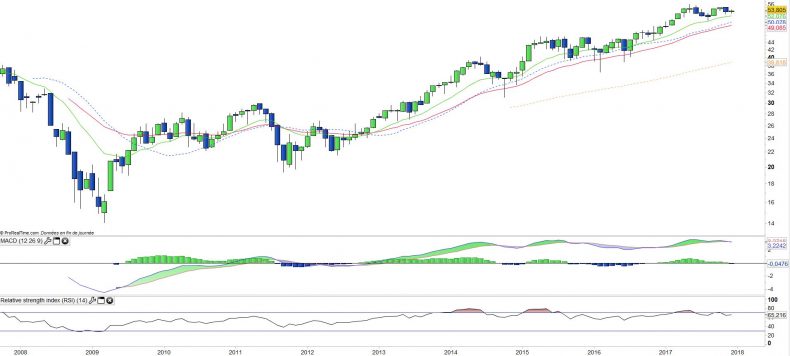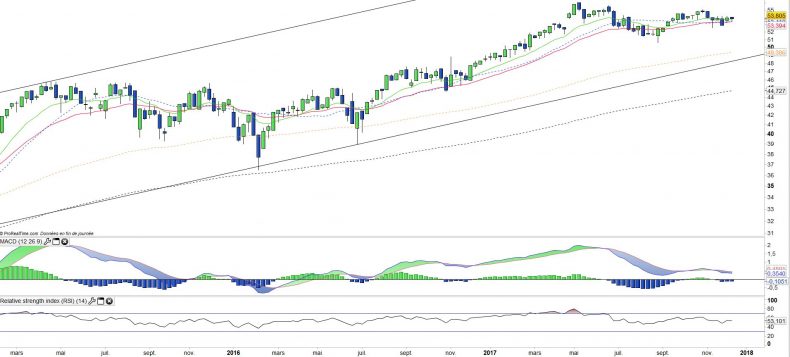Lyxor ETF Stoxx600 construction & materials (CST) -13/12/2017
Short Term strategy : Positive (70%) / Trend =
Long Term strategy : Positive (75%) / Trend =
Characteristics of the ETF
The ETF Lyxor CST (Materials & Construction Europe) created in 08/2006 is listed in Euro on Euronext and seeks to replicate the Stoxx600 Net Return Construction & Materials index composed of 21 European stocks including 33% outside the Euro zone, which implies a risk mainly related to the EURO / SEK and EURO / CHF parity.
The fees of this ETF are 0.3% and the AUM of approximately € 44m. Replication is indirect (via Swap) and there is a dividend capitalization policy.
Alternative ETFs: EXV8 (iShares in Euro)
Index & components
This index includes 21 stocks, specialized in the construction market through the cement and aggregates manufacturers such as Lafarge, CRH or Heidelberg, but also manufacturers specializing in building materials such as Saint-Gobain, as well as construction companies that can at the same time being engineering firms and dealers as Vinci, Ferrovial or Eiffage. It should be noted that the first 4 stocks (Vinci, CRH, Saint Gobain and LafargeHolcim) alone represent almost half of the capitalization of the index (49%), which is focused on European companies but whose activities are very international and for certain holdings (as CRH) includes a strong presence in the United States, while others have exposure in the emerging markets (ex: LafargeHolcim).
The construction sector was particularly affected by the financial crisis and then the Eurozone crisis between 2008 and 2012, because it is an activity that depends mainly on financing, whether for infrastructure (public authorities) or for the residential sector. The construction index seems to be gradually picking up in Europe, with the increase in building permits but still waiting for a frank recovery in Europe as growth is accelerating (2.3% estimated for 2017 in the Euro Zone), while housing construction needs are also very significant.
The outlook for the sector is now more favorable, with a recovery that is strengthening and spreading in Europe, interest rates that remain low and stable and large-scale domestic projects like Greater Paris which will represent more $ 30 billion in infrastructure investment, while in the US Donald Trump seems to have not given up on its infrastructure program, including its border wall with Mexico even though it is becoming less and less likely. Most of the growth in the sector is expected to be in the major regions of the world outside Europe, with interesting prospects in India and Africa in the medium term. China is seen as a separate market for cement-monopolized by highly competitive local price players-and hardly addressed by Western multinationals.
Latest developments
The sector's performance has been positive since 2012 (the end of the crisis), and CST has increased by 11% in 2016 (against + 1.7% for the Stoxx600) and has increased by 10.9% since the beginning of the year in line with the European benchmark. CST seems to us a good vehicle to play the recovery of the European growth in the medium and long term.
The outlook for large construction groups is generally encouraging for 2018, while European growth should accelerate and have a strong impact on industrial capacity utilization rates which are at a historically low level, due to overcapacities. For now, there is more of a problem of supply than of demand on the sector, but the rise in utilization rates, volume driven, expected in 2018 should be beneficial for margins.
CST is penalized by bad performance of Lafarge Holcim (-2% since the beginning of the year and representing currently 8.6% of the capitalization of the index) which has revised downward its FY17 forecasts and is involved in a terrorist financing case in the Middle East.
The evolution of oil prices remains to be monitored, as the cement industry is one of the biggest consumers of crude oil. A sharp rise in the price of crude would therefore penalize the margins of cement companies.
Monthly data
The monthly chart shows a positive long-term trend that has remained intact for more than 5 years, with correction phases that have so far been halted by the EMA26. The MACD is turning down, which will have to be validated at the end of the month. This is the result of a "flat" period that has lasted since the summer. An upward momentum would allow the index to get out of this range, which seems quite likely after a lateral consolidation of nearly 6 months.
Weekly data
On the weekly chart, we can observe that the flat phase of the index is becoming increasingly narrow. A renewed volatility is therefore to be expected, and the exit should occur in the direction of the underlying trend, that is to say on the rise. The oscillators are also flat but in high zone which reinforces our bullish scenario.
ETF Objective
CST is a UCITS ETF which replicates the Stoxx Europe 600 Construction & Materials Net Return index (21 companies)
Characteristics
| Inception date | 18/08/2006 |
| Expense ratio | 0,30% |
| Issuer | Lyxor |
| Benchmark | Stoxx 600 Const. & Materials |
| Ticker | CST |
| ISIN | FR0010345504 |
| UCITS | Yes |
| EU-SD Status | Out of Scope |
| Currency | € |
| Exchange | Euronext Paris |
| Assets Under Management | 44 M€ |
| Dividend | Capitalization |
| PEA (France) | Yes |
| SRD (France) | Yes |
| Number of Holdings | 21 |
| Risk | 3/5 |
Country Breakdown
| France | 39% |
| Switzerland | 20% |
| Ireland | 12% |
| Sweden | 11% |
| Spain | 7% |
| Germany | 6% |
| Others | 5% |
Sector Breakdown
| Industrials | 70% |
| Materials | 30% |
Top Ten Holdings
| Vinci | 19% |
| Saint Gobain | 11% |
| CRH | 10% |
| LafargeHolcim | 9% |
| Assa Abloy | 7% |
| Sika | 6% |
| Geberit | 5% |
| Heidelbergcement | 5% |
| Bouygues | 5% |
| Ferrovial | 4% |


